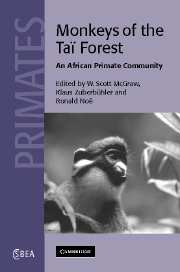Book contents
- Frontmatter
- Contents
- List of Contributors
- Preface
- 1 The monkeys of the Taï forest: an introduction
- Part I Social behavior
- Part II Anti-predation strategies
- Part III Habitat use
- Part IV Conservation
- 10 Can monkey behavior be used as an indicator for poaching pressure? A case study of the Diana guenon (Cercopithecus diana) and the western red colobus (Procolobus badius) in the Taï National Park, Côte d'Ivoire
- 11 Vulnerability and conservation of the Taï monkey fauna
- Appendix
- Index
- Plate section
- References
10 - Can monkey behavior be used as an indicator for poaching pressure? A case study of the Diana guenon (Cercopithecus diana) and the western red colobus (Procolobus badius) in the Taï National Park, Côte d'Ivoire
Published online by Cambridge University Press: 30 July 2009
- Frontmatter
- Contents
- List of Contributors
- Preface
- 1 The monkeys of the Taï forest: an introduction
- Part I Social behavior
- Part II Anti-predation strategies
- Part III Habitat use
- Part IV Conservation
- 10 Can monkey behavior be used as an indicator for poaching pressure? A case study of the Diana guenon (Cercopithecus diana) and the western red colobus (Procolobus badius) in the Taï National Park, Côte d'Ivoire
- 11 Vulnerability and conservation of the Taï monkey fauna
- Appendix
- Index
- Plate section
- References
Summary
Introduction
Market and subsistence hunting often result in the unsustainable exploitation of game in tropical forests, even when these forests are still intact (Oates et al. 2000). Poaching of wild animals is currently the major threat to the long-term conservation of the Taï National Park, Côte d'Ivoire (Hoppe-Dominik 1995, 1997, P.A.C.P.N.T. 1997). Previous studies of the effects of poaching in the Taï National Park have focused on differences in animal density and abundance between poached areas and non-poached areas (Hoppe-Dominik 1995, 1997, Refisch & Koné 2005) and on the harvest of game species within and around the park (Caspary et al. 2001). However, hunting not only affects number but also behavior (Verdade 1996). Knowledge of the impact of poaching on wildlife behavior can provide reliable indicators for the spatial and temporal development of poaching.
In addition to human hunters there are three major predators of monkeys in the Taï National Park: crowned hawk eagles (Stephanoaetus coronatus), leopards (Panthera pardus), and chimpanzees (Pan troglodytes verus). Leopards and crowned hawk eagles are typical ambush predators whose hunting success is considerably reduced if they are detected before the final strike (Hoppe-Dominik 1984, Klump & Shalter 1984, Zuberbühler et al. 1999b). In contrast, chimpanzees and humans are pursuit hunters and search for prey using acoustic cues (Gautier-Hion & Tutin 1988, Boesch & Boesch 1989). Once they have located a group, both chimpanzee and human predators reach prey in the canopy by co-operative hunting or with shotguns, respectively.
- Type
- Chapter
- Information
- Monkeys of the Taï ForestAn African Primate Community, pp. 257 - 289Publisher: Cambridge University PressPrint publication year: 2007



